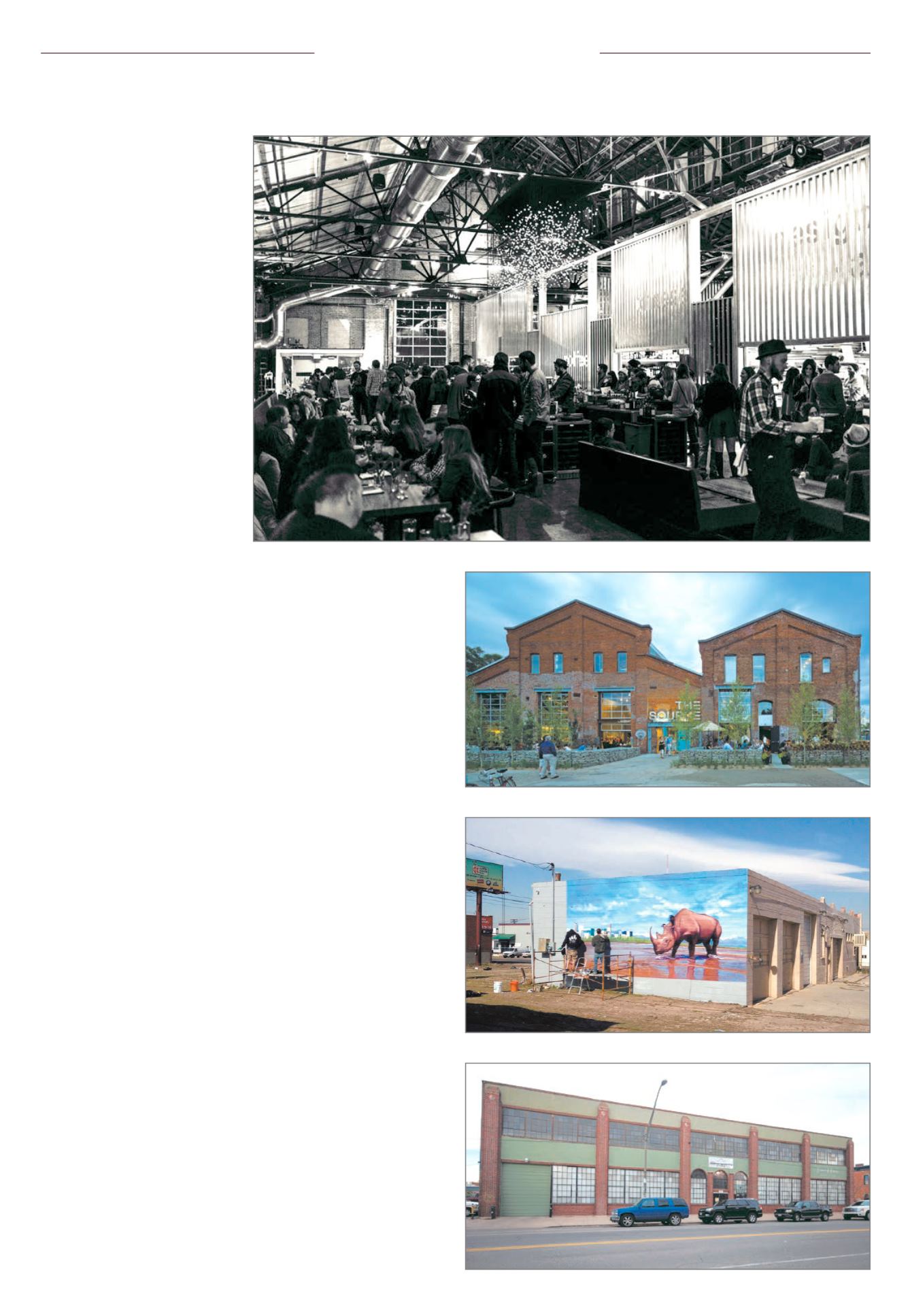

Page 16
— Retail Properties Quarterly — February 2015
by Ryan Gager
The saying goes, good things come
to those who wait. Denver’s River
North neighborhood has been wait-
ing, and now good things are com-
ing. Tracy Weil, co-founder of the
River North Art District, recalls a
time before development and even
before the area was RiNo. “When I
moved here in 2000, our closest food
sources were a 7-Eleven and Sub-
way,” said Weil. “So to see what is
happening now is great.”
What is happening is far from
national chain development. Weil
refers to RiNo as a maker’s environ-
ment, a place for the creative entre-
preneur. “What makes RiNo special
is there’s a high concentration here
and they all feed off of each other,”
said Weil. “We’re almost our own
little town.”
This momentum took several years
to gain traction. In 2005, the art dis-
trict started with eight members.
Weil and the other members were
determined to bring more people to
the area, so they held a studio tour,
built a website and distributed a
press release. Introducing the area as
RiNo, they also came up with a logo
and a phrase, “Where art is made.”
Over 1,000 people showed up for the
event.
“We went for it and had a great
turnout,” said Weil. “What I’ve
learned over the years is that com-
munity building can spur economic
development.”
The art district has grown by leaps
and bounds since its inception –
from eight members to 170, and just
last year RiNo earned the Creative
District Certification by Colorado
Creative Industries, a division of the
Colorado Office of Economic Devel-
opment & International Trade.
Many see retail in RiNo as an
escape from corporate America
and a chance to see and experi-
ence something different. “Instead
of shopping at Walmart or Target,
people come to RiNo to shop where
they can often meet the person who
made it,” said Weil. “It’s a different
spin on retail and I think makes it
more fun.”
One place in particular that has
embraced the maker’s environment
and attracted people to RiNo since
opening in 2013 is The Source. The
26,000 square-foot brick building
on Brighton Boulevard was a steel
foundry from the 19th century. Today
it is a marketplace, not only where
people can eat at one of two restau-
rants, Comida and Acorn, or a shop
at the various vendors including a
butcher, baker, liquor store, florist,
and art gallery and design store, but
also a place where people come to
meet up and socialize. The brewery
and bar inside also enhances the
atmosphere. The Source gives people
a reason to stop and take a look
around, which wasn’t always the
case in this area.
“Brighton Boulevard was always
a street that people used to drive
through to the highway,” said Weil.
“Now people are thinking they
should stop and check it out.”
The Source is one of several places
in RiNo that brings the craft, manu-
facturing and retail together, giving
customers a unique shopping expe-
rience.
Developers are finding ways to
take advantage of the large indus-
trial buildings in RiNo, once thought
a hindrance to development in this
area. Because there is not old resi-
dential or commercial to work with,
Justin Croft, project manager with
Zeppelin Development, said creativ-
ity was a tool that had to be used
often throughout development. “It
was basically a blank canvas,” said
Croft. “Mix that with the urban
energy that this area had, and that is
the recipe for the economic develop-
ment that we are seeing.”
As the last urban neighborhood
near downtown, RiNo is experienc-
ing lots of mixed-use, infill develop-
ment. “Millennials want to experi-
ence the big-city atmosphere and
in this area they are also getting the
small-town feel,” said Croft. “I think
a lot of that is anchored by the local
retailers.”
Weil said it does not take too much
convincing for retailers to move in.
However, those who are interested
must first meet with the members of
the art district. “Developers see the
vibrancy of the area and understand
the cool edginess,” said Weil. “They
are the ones who ask, ‘How can we
help you maintain that?’”
Creating mixed-use developments
and allocating space for performing
arts, creative working or shared stu-
dios helps the art district maintain
the culture in the area.
RiNo is in a phase of rapid devel-
opment. Developers understand
what consumers in this area want
and are now providing it. Another
market hall, similar to The Source,
is in the works at the H.H. Tammen
Building. Aptly named The Market, it
will be on the corner of Larimer and
27th streets and will provide fresh
and local produce, meats, cheeses,
and dry and baked goods all under
one roof.
The story of RiNo is not complete.
This area has seen many changes
over the last 15 years and will con-
tinue to progress. It will never be a
clean, sleek, national brand-name
retail area. Instead it is a raw, rough-
around-the-edges, gritty art district –
and it is becoming a popular trend.
“It’s compelling when a housing
development moves into the area,”
said Weil. “When people move in
and want to fill their space with art,
they are my customers. It is an all-
ships-rise-together mentality.”
s
Merging art and development: The story of RiNoNeighborhood Profile
Customers inside The Source market hall can shop from local vendors and artists.
The Source is a redeveloped iron foundry along Brighton Boulevard.
Several wall murals throughout RiNo represent the art and culture of the area.
The H.H. Trammen Building on 27th and Larimer streets will be redeveloped as The
Market and will sell a variety of fresh and local food.
















